 The book, Die Handschrift des Schnitt- und Augenarztes Caspar Stromayr in Lindau im Bodensee (Berlin 1925), in Falk Library’s Rodnan Room, is neither very old nor very rare. Its importance is that it brings to our attention an early ophthalmology text by Caspar Stromayr that was never published before.
The book, Die Handschrift des Schnitt- und Augenarztes Caspar Stromayr in Lindau im Bodensee (Berlin 1925), in Falk Library’s Rodnan Room, is neither very old nor very rare. Its importance is that it brings to our attention an early ophthalmology text by Caspar Stromayr that was never published before.
Caspar Stromayr was a 16th century German surgeon and ophthalmologist. A contemporary of Vesalius and Paré, he probably had some academic education, but mostly he achieved highly specialized knowledge through reading, consultations with other physicians, and empirical observations while practicing as a town surgeon in his native town of Lindau. He died there around 1566. In his lifetime, he did not influence 16th century medicine, his skills and knowledge were forgotten, and his eloquent unpublished work was buried in the library for almost 400 years. Today, however, he stands out among his contemporaries thanks to the manuscript he left behind.
His Practica Copiosa mostly deals with the surgery of hernia, to which there are two appended chapters on the surgery of the eye. The latter might have been intended to be a separate work, because the illustrations do not align with the original text, which has blanks where the illustration figures should be. Stromayr’s observations and thoughts were original and ahead of his time. The appended chapters on the etiology of cataracts and their treatment are of special importance because they are the first German ophthalmology work of known authorship.
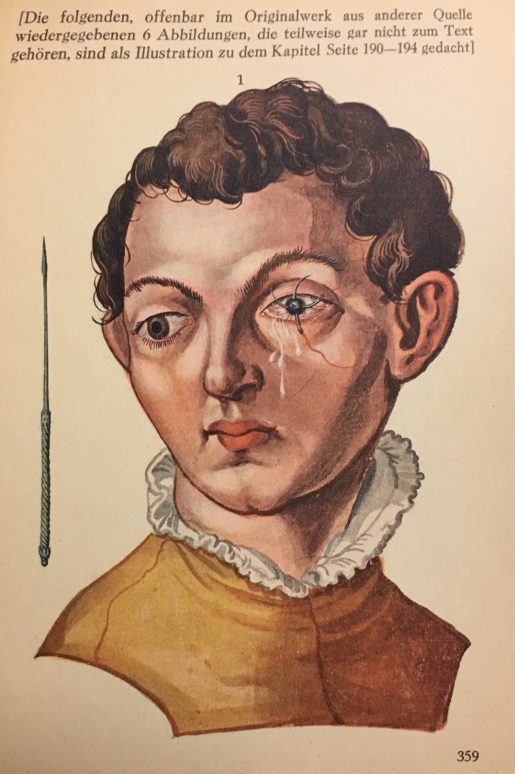 The richly illustrated manuscript was brought to light in 1925, when it was published by surgical historian Walter von Brunn. The English translation makes the text even more accessible. Nine out of 186 plates relate to the ophthalmology chapters. The plate presented on the right shows the eye with mature cataract undergoing a procedure with a threaded curved needle.
The richly illustrated manuscript was brought to light in 1925, when it was published by surgical historian Walter von Brunn. The English translation makes the text even more accessible. Nine out of 186 plates relate to the ophthalmology chapters. The plate presented on the right shows the eye with mature cataract undergoing a procedure with a threaded curved needle.
An exhibit on the history of cataract surgery is currently on display in the Falk Library lobby.
~Gosia Fort
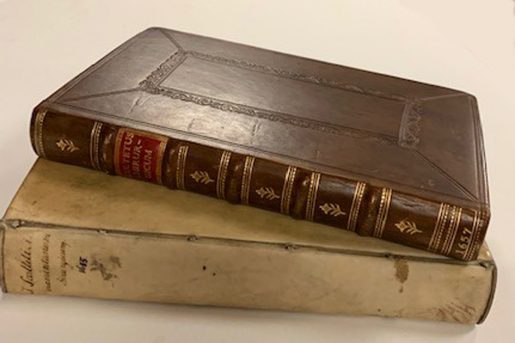
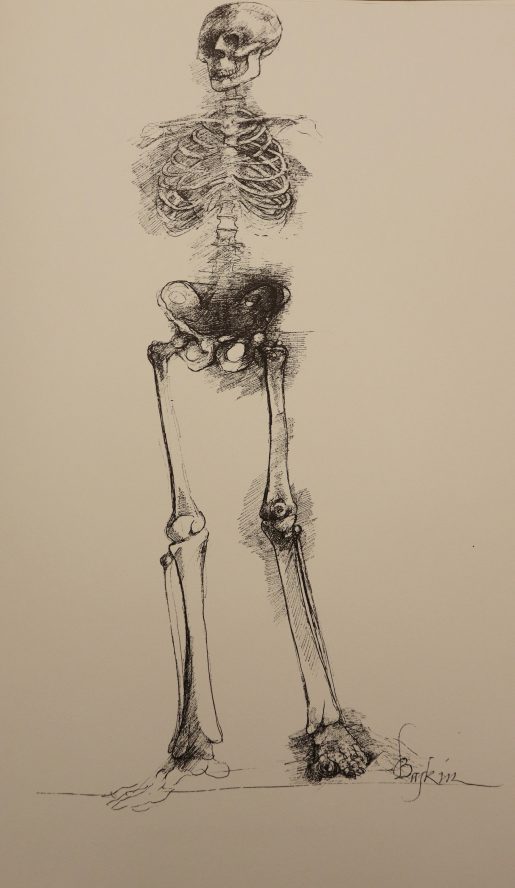 Leonard Baskin’s Ars Anatomica: a medical fantasia, thirteen drawings (1972) is the most recent addition to our historical collection. The book was donated by Dr. Brian Primack, the former dean of Pitt’s Honors College. The portfolio includes thirteen anatomical drawings commissioned by Editions Medicina Rara from a contemporary artist, Leonard Baskin (1922-2000).
Leonard Baskin’s Ars Anatomica: a medical fantasia, thirteen drawings (1972) is the most recent addition to our historical collection. The book was donated by Dr. Brian Primack, the former dean of Pitt’s Honors College. The portfolio includes thirteen anatomical drawings commissioned by Editions Medicina Rara from a contemporary artist, Leonard Baskin (1922-2000).

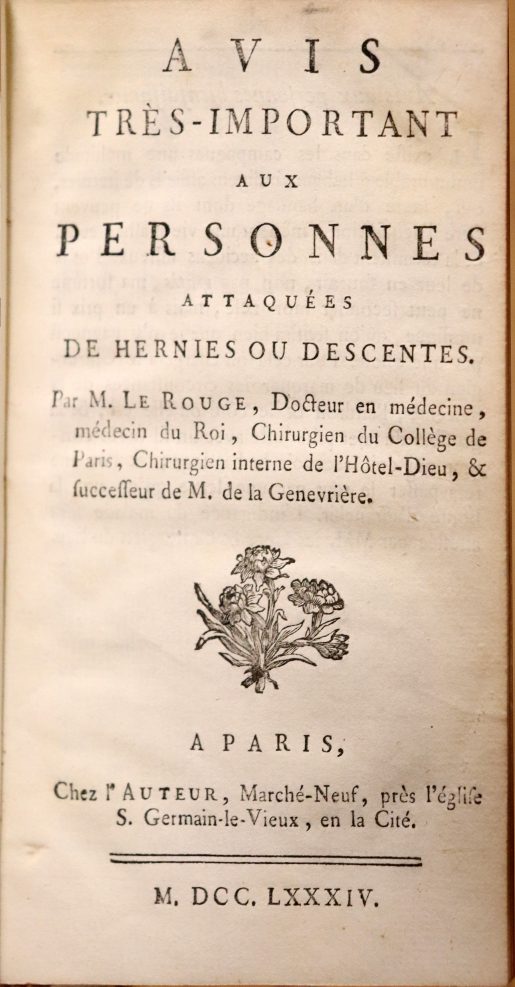 We know very little about the author of an unusual book on hernia found in the Falk Library Rare Book Collection. Jean Pierre Le Rouge was a surgeon at the College of Surgeons in Paris and at the Hôtel-Dieu in the second half of the 18th century and was the author of two books on hernias. He had 17 years of experience working at the biggest hospital in Paris, Hôtel-Dieu, when he published his first popular work Avis très important aux personnes attaquées de hernies ou descentes [Translation: Very important notice to people attacked by hernia] in 1784. A year later, in 1785, his thesis Dissertatio anatomico-chirurgica de perfecta inguinalis herniae simplicis curatione [Translation: Thesis on the treatment of inguinal hernia] appeared. Both books are very scarce.
We know very little about the author of an unusual book on hernia found in the Falk Library Rare Book Collection. Jean Pierre Le Rouge was a surgeon at the College of Surgeons in Paris and at the Hôtel-Dieu in the second half of the 18th century and was the author of two books on hernias. He had 17 years of experience working at the biggest hospital in Paris, Hôtel-Dieu, when he published his first popular work Avis très important aux personnes attaquées de hernies ou descentes [Translation: Very important notice to people attacked by hernia] in 1784. A year later, in 1785, his thesis Dissertatio anatomico-chirurgica de perfecta inguinalis herniae simplicis curatione [Translation: Thesis on the treatment of inguinal hernia] appeared. Both books are very scarce.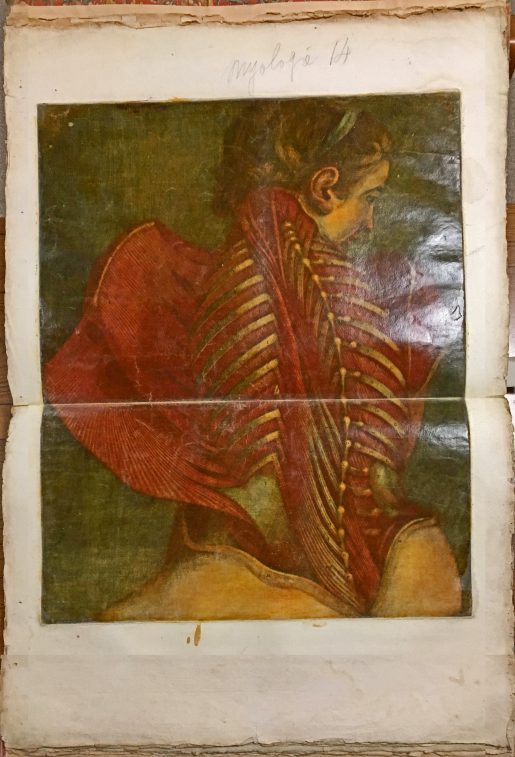


 John K’eogh (1681-1754) was an Irish naturalist and the author of Botanologia Universalis Hibernica (1735), an early Irish herbal, and Zoologia Medicinalis Hibernica (1739). His intent with both works was to show that his country was self-sufficient to produce all remedies to cure the locals of any sickness without the need to import foreign medicines.
John K’eogh (1681-1754) was an Irish naturalist and the author of Botanologia Universalis Hibernica (1735), an early Irish herbal, and Zoologia Medicinalis Hibernica (1739). His intent with both works was to show that his country was self-sufficient to produce all remedies to cure the locals of any sickness without the need to import foreign medicines.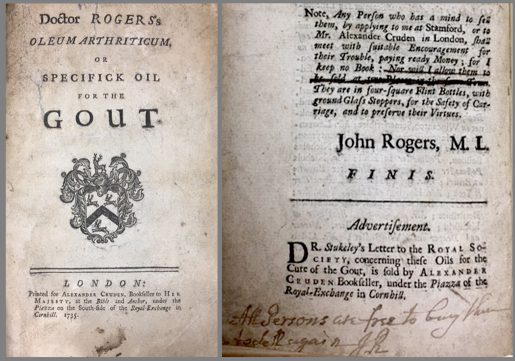
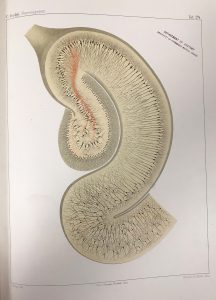
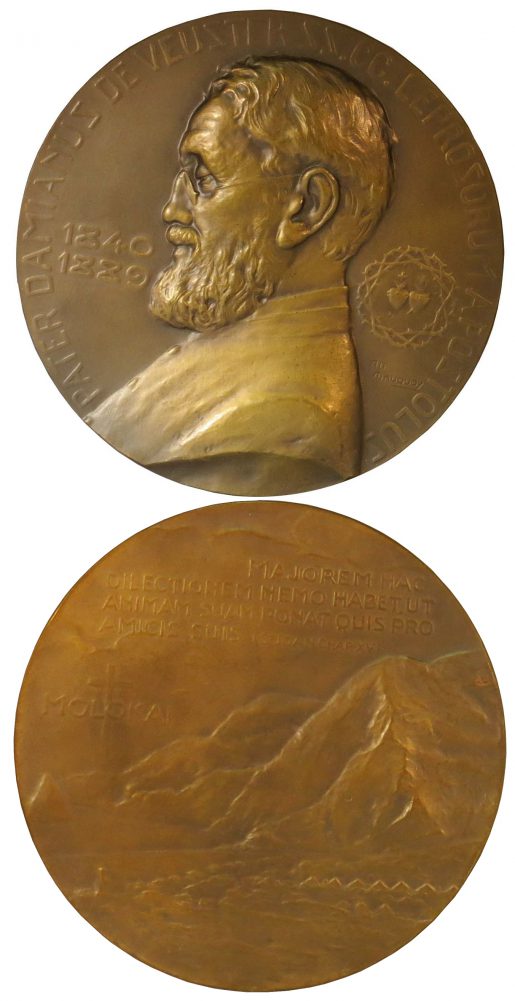
 Although he was not a loveable person, his innovative teaching methods, and the excellent books he authored, earned him the respect of the medical profession. He is remembered as a great surgeon, anatomist, and discoverer of the naso-palatine nerve. His study of the hearing and olfactory organs is considered classic. He was the first to correctly delineate the nerves of the heart. In his authoritative works on hernia, he described perineal hernia from direct observations, thus settling any earlier controversy of its existence. His work, Saggio di osservazioni e d’esperienze sulle principali malattie degli occhi (Practical observations on the principal diseases of the eyes, 1806), raised ophthalmology to the level of an autonomous science. Plate I from this work is one of the most famous illustrations in medicine, in which science and art become one.
Although he was not a loveable person, his innovative teaching methods, and the excellent books he authored, earned him the respect of the medical profession. He is remembered as a great surgeon, anatomist, and discoverer of the naso-palatine nerve. His study of the hearing and olfactory organs is considered classic. He was the first to correctly delineate the nerves of the heart. In his authoritative works on hernia, he described perineal hernia from direct observations, thus settling any earlier controversy of its existence. His work, Saggio di osservazioni e d’esperienze sulle principali malattie degli occhi (Practical observations on the principal diseases of the eyes, 1806), raised ophthalmology to the level of an autonomous science. Plate I from this work is one of the most famous illustrations in medicine, in which science and art become one.